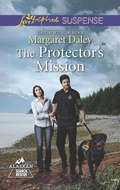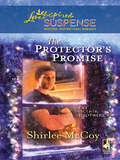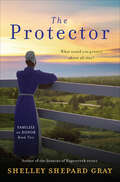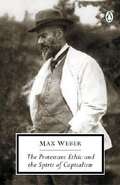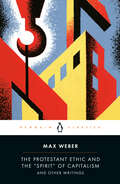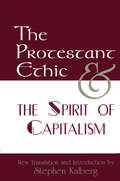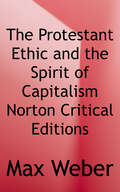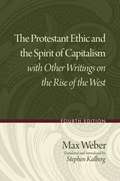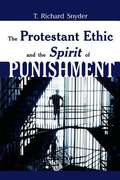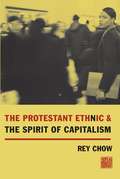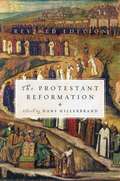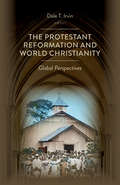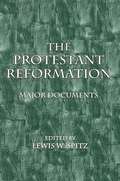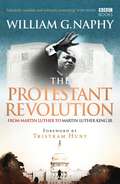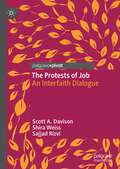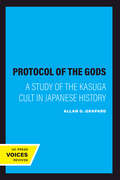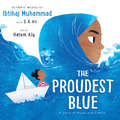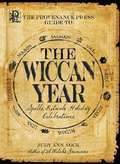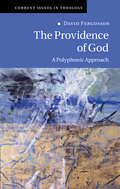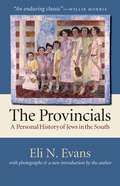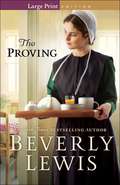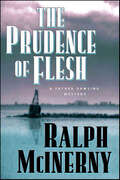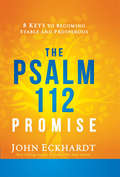- Table View
- List View
The Protector's Mission
by Margaret DaleyDEADLY EXPLOSION Lydia McKenzie is the only living witness to a serial bomber's latest threat. Surviving the explosion at the café, Lydia is rescued by police sergeant Jesse Hunt and his K-9 partner, a Rottweiler named Brutus. She's struggling to remember details of the incident. But one thing she'll never forget is how she once felt about Jesse-the high school sweetheart she left to marry another. In charge of her protection, the guarded cop believes the bomber's after her, and he promises to keep her safe. But as more of Lydia's memories return, the more the vicious killer wants her dead. Alaskan Search and Rescue: Risking their lives to save the day
The Protector's Promise (The Sinclair Brothers #2)
by Shirlee McCoyNew York Times–Bestselling Author: He means to keep a widow and her daughter safe in their home—but can he keep his own heart safe along the way?Who could want to hurt a little girl in a pink princess dress? Grayson Sinclair vows to find out who’s after his widowed neighbor and her child—without getting emotionally involved. Family life isn’t for him, but he won’t let some deranged person destroy the lovely home Honor Milone has made for her daughter.From strange “gifts” left on her doorstep to attempted murder, someone means deadly business. Grayson promises to protect Honor and the little girl who sneakily stole his heart. Just in time. For the threat is closer to home than anyone realizes . . .
The Protector: Families Of Honor, Book Two (Families of Honor #2)
by Shelley Shepard GrayLove comes to a woman who just needs the faith to accept it in The Protector from New York Times bestselling author Shelley Shepard Grey.Unable to look after her fifty-acres of farmland following her parents’ death, Ella has no choice but to put her family’s land up for auction. Loyal Weaver purchases the farm and immediately begins renovating its buildings, including Ella’s home. Invited to participate in her former property’s makeover, Ella finds herself in Loyal’s presence, offering her opinions and ideas, and enjoying spending time with the man she’s always loved from afar. But as Ella and Loyal grow closer, her best friend warns her that he’s not the pillar of their Amish community, but someone with mysterious secrets and questionable motives. Now, Ella is torn between her friend’s claims and Loyal’s attentions, wondering if she can trust her own heart.But what Ella doesn’t know is that Loyal does have a secret. He wants her to be his wife. . . “Shelley Shepard Gray writes with honesty, tenderness, and depth. Her characters are admirable, richly-layered, and impossible to forget.” —New York Times bestselling author Jillian HartFamilies of HonorThe CaregiverThe ProtectorThe Survivor
The Protestant Ethic and Other Writings
by Max WeberIn The Protestant Ethic, Max Weber opposes the Marxist concept of dialectical materialism and relates the rise of the capitalist economy to the Calvinist belief in the moral value of hard work and the fulfillment of one's worldly duties. Edited, introduced and translated by Gordon C. Wells and Peter Baehr
The Protestant Ethic and the Spirit of Capitalism
by Max WeberIn The Protestant Ethic, Max Weber opposes the Marxist concept of dialectical materialism and relates the rise of the capitalist economy to the Calvinist belief in the moral value of hard work and the fulfillment of one's worldly duties. Based on the original 1905 edition, this volume includes, along with Weber's treatise, an illuminating introduction, a wealth of explanatory notes, and exemplary responses and remarks-both from Weber and his critics-sparked by publication of The Protestant Ethic and the Spirit of Capitalism. This is the first English translation of the 1905 German text and the first volume to include Weber's unexpurgated responses to his critics, which reveal important developments in and clarifications of Weber's argument.
The Protestant Ethic and the Spirit of Capitalism
by Max WeberFor the first time in 70 years, a new translation of Max Weber's classic The Protestant Ethic and the Spirit of Capitalism --one of the seminal works in sociology-- published in September 2001. Translator Stephen Kalberg is an internationally acclaimed Weberian scholar, and in this new translation he offers a precise and nuanced rendering that captures both Weber's style and the unusual subtlety of his descriptions and causal arguments. Weber's original italicization, highlighting major themes, has been restored, and Kalberg has standardized Weber's terminology to better facilitate understanding of the various twists and turns in his complex lines of reasoning.Weber's compelling work remains influential for these reasons: it explores the continuing debate regarding the origins and legacy of modem capitalism in the West; it helps the reader understand today's global economic development; and it plumbs the deep cultural forces that affect contemporary work life and the workplace in the United States and Europe.This new edition/translation also includes a glossary; Weber's 1906 essay, "The Protestant Sects and the Spirit of Capitalism"; and Weber's masterful prefatory remarks to his Collected Essays in the Sociology of Religion, in which he defines the uniqueness of Western societies and asks what "ideas and interests" combined to create modem Western rationalism
The Protestant Ethic and the Spirit of Capitalism (Norton Critical Editions Series)
by Max WeberThis landmark work sets out the relationship between Western religious ethos and the emergence and growth of capitalism; its thesis being that the values of hard work and industry at the core of ascetic Protestantism made it possible for modern rational capitalism to flourish. <p><p>This Norton Critical Edition is based on the Talcott Parsons translation (1930). It is accompanied by the Translator's Note and explanatory annotations."Interpretations" includes five major scholarly essays on Weber and The Protestant Ethic and the Spirit of Capitalism by Ola Agevall, Richard F. Hamilton, Gudmund Hernes, Peter Breiner, and Richard Swedberg.A Chronology of Weber's life and work, a Selected Bibliography, and an Index are also included.
The Protestant Ethic and the Spirit of Capitalism with Other Writings on the Rise of the West
by Max Weber Stephen KalbergFor more than 100 years, The Protestant Ethic and the Spirit of Capitalism has set the parameters for the debate over the origins of modern capitalism. Now more timely and thought-provoking than ever, this esteemed classic of twentieth-century social science examines the deep cultural "frameof mind" that influences work life to this day in northern America and Western Europe. Stephen Kalberg's internationally acclaimed translation captures the essence of Weber's style as well as the subtlety of his descriptions and causal arguments. Now, for the first time in one volume, The Protestant Ethic and the Spirit of Capitalism with Other Writings on the Rise of the West integrates Weber's exploration of the spirit of capitalism's origins with his larger project: a multi-causal analysis of the West's distinctiveness and its sources. Weber's texts present wide-ranging discussions on the Western city, state, forms of rulership and law, and modes of economic innovation. Moreover, in many selections Weber offers in-depth and insightful comparisons to China and India. Readings on the "economic ethics" of Confucianism, Buddhism,Hinduism, Islam, Judaism, and Catholicism further illuminate the distinct qualities of the West's trajectory and its diverse causes. A separate section examines the long-range influence of the ascetic Protestant sects and churches on American society. To draw readers into the material, this engaging volume includes extended introductions by the editor, many new translations, a chronology of Weber's life, an expanded glossary and bibliography, and numerous clarifying endnotes. In addition, Kalberg addresses a variety of debates concerning thecentral elements of contemporary life. Ideal for courses in sociology, anthropology, political science, history, international relations, and economics, The Protestant Ethic and the Spirit of Capitalism with Other Writings on the Rise of the West is an essential resource for anyone seeking tounderstand the origins and endurance of the modern West.
The Protestant Ethic and the Spirit of Capitalism: and Other Writings
by Peter Baehr Max Weber Gordon C. WellsIn The Protestant Ethic, Max Weber opposes the Marxist concept of dialectical materialism and relates the rise of the capitalist economy to the Calvinist belief in the moral value of hard work and the fulfillment of one's worldly duties.
The Protestant Ethic and the Spirit of Capitalism: and Other Writings
by Peter Baehr Max Weber Gordon C. WellsIn The Protestant Ethic, Max Weber opposes the Marxist concept of dialectical materialism and relates the rise of the capitalist economy to the Calvinist belief in the moral value of hard work and the fulfillment of one's worldly duties.
The Protestant Ethic and the Spirit of Punishment
by T. Richard SnyderThe Protestant Ethic and the Spirit of Punishment is an eye-opening work with profound implications for contemporary social life. Snyder shows that the spirit of punishment in our culture is rooted in and reinforced by popular Christian misunderstandings of human nature and God's grace and initiates fresh ways of thinking about the traditional theological concepts of covenant, incarnation, and trinity as foundations for a restorative approach to justice. He also challenges religious communities to understand God's good news in ways that offer hope for a transformed world.
The Protestant Ethnic and the Spirit of Capitalism
by Rey ChowIn late-capitalist Western society, cross-ethnic cultural transactions are an inevitable daily routine. Yet, according to acclaimed cultural critic Rey Chow, the notion of ethnicity as it is currently used is theoretically ambivalent, confusing, indeed self-contradictory, straddling as it does an uneasy boundary between a universalist rhetoric of inclusion on the one hand, and actual, lived experiences of violence and intolerance on the other. To drastically reconceptualize ethnicity in the contemporary world, Chow proposes that it be examined in conjunction with Max Weber's famous theory about the Protestant work ethic and capitalism, which holds that secular belief in salvation often collaborates effectively with the interpellation, disciplining, and rewarding of subjects constituted by specific forms of labor. The charged figure that results from such a collaboration, resonant with the economic, psychological, and spiritual implications of the word "protest, " is what she refers to as the protestant ethnic.Chow explores the vicissitudes of cross-ethnic representational politics in a diverse range of texts across multiple genres, including the writings of Georg Lukacs, Michel Foucault, Max Weber, Jacques Derrida, Fredric Jameson, Etienne Balibar, Charlotte Brontë, Garrett Hongo, John Yau, and Frantz Fanon; the films of Alfred Hitchcock, Marguerite Duras, and Alain Resnais; and the cartoon drawings of Larry Feign. Tracing out hauntingly familiar scenarios from stereotyping and coercive mimeticism to collective narcissistic abjection, the rise of white feminist racial power, and intraethnic ressentiment, Chow articulates a series of interlocking critical dialogues that challenge readers into hitherto unimagined ways of thinking about an urgent topic.
The Protestant Reformation
by Hans J. HillerbrandOriginally published more than forty years ago, this important collection brings together the works and writings of the revolutionary minds behind the Protestant Reformation--and it remains a major resource for teachers, students, and history buffs alike. Over the decades, however, modern scholarship has shed new light on this tumultuous period, raising probing questions and providing new connections that have radically changed our understanding and outlook. With this newly revised and updated edition of this essential work--now including texts written by women as well as entries dealing with popular religion--modern viewpoints are cogently addressed, while the scholarly integrity that has made this book a revered classic has been scrupulously maintained. Throughout, Hans J. Hillerbrand's basic assumption remains consistent: religion--no matter how dependent on societal forces--must be seen as the pivotal element in the story of the sixteenth century.
The Protestant Reformation and World Christianity: Global Perspectives
by Dale T. IrvinThe sixteenth-century Reformation in all its forms and expressions sought nothing less than the transformation of the Christian faith. Five hundred years later, in today's context of world Christianity, the transformation continues. In this volume, editor Dale Irvin draws together a variety of international Christian perspectives that open up new understandings of the Reformation. In six chapters, contributors offer general discussions and case studies of the effects of the Protestant Reformation on global communities from the sixteenth century to the present. Together, these essays encourage a reading and interpretation of the Reformation that will aid in the further transformation of Christianity today.CONTENTS: Introduction 1. Jews and Muslims in Europe: Exorcising Prejudice against the Other Charles Amjad-Ali 2. Spaniards in the Americas: Las Casas among the Reformers Joel Morales Cruz 3. Women from Then to Now: A Commitment to Mutuality and Literacy Rebecca A. Giselbrecht 4. The Global South: The Synod of Dort on Baptizing the "Ethnics" David D. Daniels 5. The Protestant Reformations in Asia: A Blessing or a Curse? Peter C. Phan 6. The Modern Era: Contemporary Challenges in Light of the Reformation Vladimir Latinovic
The Protestant Reformation: Major Documents
by Lewis W. Spitz William R. KenanA series of statements from men and women dating between 1501 to 1559. Each statement illustrates discontent with the church and a determination to change it.
The Protestant Revolution: From Martin Luther to Martin Luther King Jr.
by William G. NaphyWhen Martin Luther nailed 95 criticisms of the Catholic Church to the door of his local church in 1517 he sparked not just a religious Reformation, but an unending cycle of political, social and economic change that continues to this day. By challenging the authority of the Pope, Luther inadvertently unleashed a revolutionary force: the power of the individual to determine his or her own thoughts and actions. Over four centuries later, the Protestant minister Martin Luther King Jr was acting on the same revolutionary principle when he rejected racial discrimination and spearheaded the US Civil Rights Movement.The legacy of the Reformation is all around us, influencing our work life, our family life, even our sex life, as well as our political views and sense of national identity. From literature to science, from gay marriage to the 'War on Terror', a vibrant struggle for Protestant principles is alive in Britain, America and the developing world.This is the story of the Reformation and its lasting legacy - in effect, how Protestantism created the modern world.
The Protests of Job: An Interfaith Dialogue
by Shira Weiss Scott A. Davison Sajjad RizviThis book explores the protests of Job from the perspectives of Jewish, Christian, and Islamic religious and philosophical traditions. Shira Weiss examines how challenges to divine justice are understood from a Jewish theological perspective, including the pro-protest and anti-protest traditions within rabbinic literature, in an effort to explicate the ambiguous biblical text and Judaism’s attitude towards the suffering of the righteous. Scott Davison surveys Christian interpretations of the book of Job and the nature of suffering in general before turning to a comparison of the lamentations of Jesus and Job, with special attention to the question of whether complaints against God can be expressions of faith. Sajjad Rizvi presents the systematic ambiguity of being present in monistic approaches to reality as one response to evil and suffering in Islam, along with approaches that attempt a resolution through the essential erotic nature of the cosmos, and explores the suggestion that Job is the hero of a metaphysical revolt that is the true sign of a friend of God. Each author also provides a response essay to the essays of the other two authors, creating an interfaith dialogue around the problem of evil and the idea of protest against the divine.
The Protocol of the Gods: A Study of the Kasuga Cult in Japanese History
by Allan G. GrapardThe Protocol of the Gods is a pioneering study of the history of relations between Japanese native institutions (Shinto shrines) and imported Buddhist institutions (Buddhist temples). Using the Kasuga Shinto shrine and the Kofukuji Buddhist temple, one of the oldest and largest of the shrine-temple complexes, Allan Grapard characterizes what he calls the combinatory character of pre-modern Japanese religiosity. He argues that Shintoism and Buddhism should not be studied in isolation, as hitherto supposed. Rather, a study of the individual and shared characteristics of their respective origins, evolutions, structures, and practices can serve as a model for understanding the pre-modern Japanese religious experience.Spanning the years from a period before historical records to the forcible separation of the Kasuga-Kofukuji complex by the Meiji government in 1868, Grapard presents a wealth of little-known material. He includes translations of rare texts and provides new, accessible translations of familiar documents.
The Proudest Blue: A Story of Hijab and Family
by Ibtihaj MuhammadA powerful, vibrantly illustrated story about the first day of school--and two sisters on one's first day of hijab--by Olympic medalist and social justice activist Ibtihaj Muhammad. With her new backpack and light-up shoes, Faizah knows the first day of school is going to be special. It's the start of a brand new year and, best of all, it's her older sister Asiya's first day of hijab--a hijab of beautiful blue fabric, like the ocean waving to the sky. But not everyone sees hijab as beautiful, and in the face of hurtful, confusing words, Faizah will find new ways to be strong.Paired with Hatem Aly's beautiful, whimsical art, Olympic medalist Ibtihaj Muhammad and Morris Award finalist S.K. Ali bring readers an uplifting, universal story of new experiences, the unbreakable bond between siblings, and of being proud of who you are.
The Provenance Press™ Guide To The Wiccan Year
by Judy Ann NockIn The Provenance Press Guide to the Wiccan Year, High Priestess Judy Ann Nock offers a definitive guide to the Wheel of the Year. Capturing the essence of both the major and lesser holidays, this complete and practical reference offers something for everyone, from history and recipes, to crafts and rituals, spells and meditations, regardless of your level of practice. There are many ways to acknowledge the passage of time, whether the observance is simple or elaborate. In these pages, there are several appropriate cyclic activities to honor the changing of the seasons. Written to inspire and expand your practice as you move through the eight Sabbats, Nock provides you with: * The astrological and astronomical influences that govern the seasons * Meditations that reflect timely themes * Rituals and crafts to enhance your spiritual expression Beginning with Samhain, the witch's New Year, and ending with the harvest of Mabon, The Provenance Press Guide to the Wiccan Year enables you to deepen your spiritual path, regardless of the time of year.
The Providence of God: A Polyphonic Approach (Current Issues in Theology #11)
by David FergussonThe concept of providence is embedded in the life and theology of the church. Its uses are frequent and varied in understandings of politics, nature, and individual life-stories. Parallels can be discerned in other faiths. In this volume, David Fergusson traces the development of providential ideas at successive periods in church history. These include the early appropriation of Stoic and Platonic ideas, the codification of providence in the Middle Ages, its foregrounding in Reformed theology, and its secular applications in the modern era. Responses to the Lisbon earthquake (1755) provide an instructive case study. Although confidence in divine providence was shaken after 1914, several models were advanced during the twentieth century. Drawing upon this diversity of approaches, Fergusson offers a chastened but constructive account for the contemporary church. Arguing for a polyphonic approach, he aims to distribute providence across all three articles of the faith.
The Provincials
by Eli N. EvansIn this classic portrait of Jews in the South, Eli N. Evans takes readers inside the nexus of southern and Jewish histories, from the earliest immigrants to the present day. Evoking the rhythms and heartbeat of Jewish life in the Bible belt, Evans weaves together chapters of recollections from his youth and early years in North Carolina with chapters that explore the experiences of Jews in many cities and small towns across the South. He presents the stories of communities, individuals, and events in this quintessential American landscape that reveal the deeply intertwined strands of what he calls a unique "Southern Jewish consciousness." First published in 1973 and updated in 1997, The Provincials was the first book to take readers on a journey into the soul of the Jewish South, using autobiography, storytelling, and interpretive history to create a complete portrait of Jewish contributions to the history of the region. No other book on this subject combines elements of memoir and history in such a compelling way. This new edition includes a gallery of more than two dozen family and historical photographs as well as a new introduction by the author.
The Proving
by Beverly LewisAfter five years as an Englisher, Amanda Dienner is shocked to learn her mother has passed away and left her Lancaster County's most popular Amish bed-and-breakfast. What's more, the inn will only truly be hers if Mandy can successfully run it for twelve months. Reluctantly, Mandy accepts the challenge, no matter that it means facing the family she left behind--or that the inn's clientele expect an Amish hostess! Can Mandy fulfill the terms of her inheritance? Or will this prove a dreadful mistake?
The Prudence of the Flesh (Father Dowling Mysteries)
by Ralph McInernyGregory Barrett, a classmate of Father Dowling's, left the priesthood twenty-five years ago. Now, after all these years, a woman threatens to bring a multimillion-dollar suit against him, alleging he sexually exploited her when he was still a priest and she was sixteen. Barrett has no memory of her, but is devastated at what these claims will do to his career as a radio host and to his new family. So he comes to Father Dowling for advice. Father Dowling, a parish priest in Fox River, Illinois, as usual, serves as part counselor, part sounding board, and part moral compass for priests and parishioners alike---not to mention cops and lawyers---and offers help to both Barrett and his accuser.Before Barrett can decide what to do, and before the now-adult woman has made her demands known to the archdiocese, a body washes up on the shore of Lake Michigan, and Barrett becomes the primary suspect in the murder.Also in the mix in this astutely drawn mystery are a failed writer, a parish busybody, an inept lawyer, and an embittered young man, each with his or her own agenda, and it is up to Father Dowling to unravel the links between these people whose lives were separated long ago, only to reconnect in tragedy.
The Psalm 112 Promise: 8 Keys to Becoming Stable and Prosperous
by John EckhardtProsperity is more than having a lot of money. It&’s more than having solid relationships and a healthy mind and body. You can be filled with the Holy Spirit, praise God, and worship or even prophesy, speak in tongues, and cast out demons, and yet still be unable to maintain a balanced and prosperous life. The truth is, without inner stability any outward prosperity will not last. Best-selling author John Eckhardt turns to Psalm 112 to unearth the keys to being truly prosperous. Explore the eight characteristics of a balanced, stable, steadfast, immovable believer, and learn how to also become one. Featuring prayers and declarations, this step-by-step guide will help you achieve not just wholeness in your relationships, finances, and health, but also restoration in your heart and soul.
